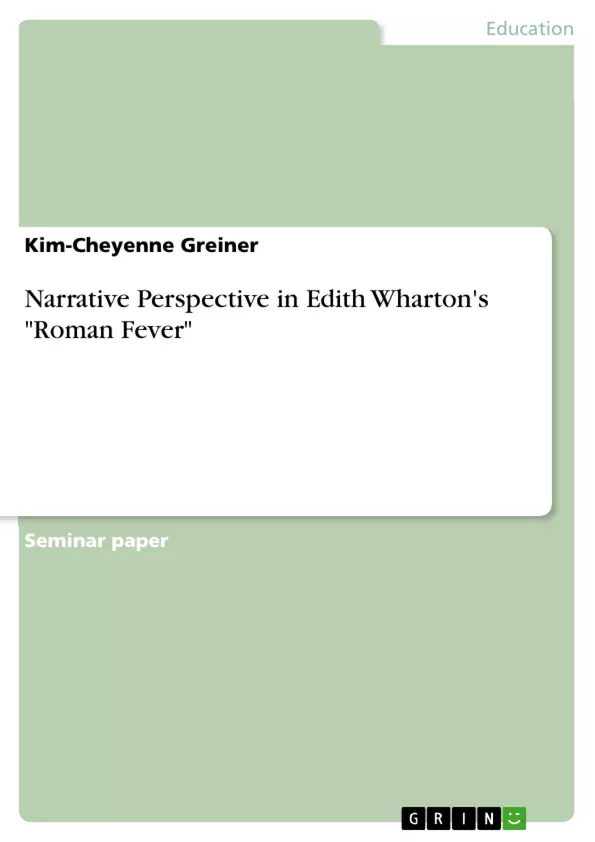Edith Wharton's "The Writing of Fiction" explores narrative techniques crucial for crafting compelling stories. Focused on her short story "Roman Fever," this essay delves into Wharton's emphasis on narrator control, concealment, and strategic revelation of story elements. Wharton advocates for revealing insights through specific fragments, constructing a captivating whole and maintaining audience interest.
Examining "Roman Fever," the essay argues that Wharton skillfully connects narrative construction with gradual character secret disclosure. The story unfolds on a Roman terrace, concealing secrets until a climactic revelation involving American women Grace Ansley and Alida Slade. Selected passages illustrate Wharton's deliberate shaping of perspective, emphasizing her preference for withholding closure.
The analysis centers on Wharton's use of an omniscient narrator and internal focalization on Alida Slade, exploring how the narrative voice mediates content, controlling readers' perspectives on events and characters. The essay delves into the intricacies of the second story construction, providing a detailed examination.
The goal is to draw insightful conclusions about Wharton's narrative techniques and their impact on temporal disclosure. This exploration promises readers a deeper understanding of Wharton's literary craftsmanship and an enriched appreciation for the interplay between narrative perspective and storytelling construction in "Roman Fever."
Table of Contents
- 1. Introduction
- 2. Narrative Construction of "Roman Fever"
- 2.1. Omniscient Narration and Internal Focalization
- 2.2. First and Second Story
- 3. Conclusion
Objectives and Key Themes
This paper analyzes Edith Wharton's short story "Roman Fever," focusing on how narrative construction contributes to the temporizing of character secrets and the story's "surprise ending." The paper examines Wharton's techniques in creating suspense and controlling reader perspective.
- The role of omniscient narration and internal focalization in delaying crucial information.
- The use of "major tensions" and seemingly insignificant details to build suspense.
- The impact of Wharton's narrative choices on the reader's understanding of the characters and their motivations.
- The effectiveness of Wharton's narrative strategy in creating a surprising and impactful conclusion.
- Analysis of the "second story" construction within the narrative.
Chapter Summaries
1. Introduction: This introductory chapter establishes the central argument of the paper: that Edith Wharton masterfully employs narrative techniques to control the disclosure of secrets in her short story "Roman Fever." It draws upon Wharton's own writing on fiction to highlight the importance of carefully constructed openings and the strategic withholding of information to maintain reader engagement. The chapter introduces the key characters, Grace Ansley and Alida Slade, and their meeting in Rome, setting the stage for the analysis of the narrative strategies used to build suspense and reveal the story's central secret in a climactic moment.
2. Narrative Construction of "Roman Fever": This chapter delves into the specific narrative techniques Wharton uses to control the flow of information and build suspense. It breaks down the analysis into two subsections focusing on the effects of omniscient narration and internal focalization, and the structure of the "second story." The chapter explores how Wharton's narrative voice carefully manages the reader's access to the characters' thoughts and feelings, strategically withholding key information until the story's dramatic conclusion.
Keywords
Edith Wharton, Roman Fever, narrative technique, omniscient narration, internal focalization, suspense, secret, disclosure, surprise ending, second story, short story, narrative perspective.
Edith Wharton's "Roman Fever": A Narrative Analysis - FAQ
What is the main focus of this paper?
This paper analyzes Edith Wharton's short story "Roman Fever," focusing on how narrative construction contributes to the temporizing of character secrets and the story's "surprise ending." It examines Wharton's techniques in creating suspense and controlling reader perspective.
What are the key themes explored in the paper?
The paper explores several key themes, including the role of omniscient narration and internal focalization in delaying crucial information; the use of "major tensions" and seemingly insignificant details to build suspense; the impact of Wharton's narrative choices on the reader's understanding of the characters and their motivations; the effectiveness of Wharton's narrative strategy in creating a surprising and impactful conclusion; and an analysis of the "second story" construction within the narrative.
What narrative techniques are analyzed in the paper?
The paper analyzes Wharton's use of omniscient narration, internal focalization, and the strategic structuring of a "second story" within the narrative. These techniques are examined in terms of how they control the flow of information, build suspense, and ultimately contribute to the story's surprising conclusion.
How does the paper analyze the "surprise ending"?
The paper analyzes how Wharton's careful control of information through narrative technique leads to the story's surprising and impactful conclusion. The strategic withholding of key details and the manipulation of reader perspective are central to this analysis.
What is the structure of the paper?
The paper is structured into an introduction, a main chapter analyzing the narrative construction of "Roman Fever," and a conclusion. The main chapter is further divided into subsections focusing on omniscient narration and internal focalization, and the structure of the "second story" within the narrative.
What are the key takeaways from the chapter summaries?
The introduction establishes the central argument, highlighting Wharton's masterful use of narrative techniques to control the disclosure of secrets. The main chapter delves into the specific techniques, analyzing how Wharton manages the reader's access to characters' thoughts and feelings, strategically withholding information until the climax. The analysis emphasizes the impact of these techniques on building suspense and creating a surprising conclusion.
What keywords are associated with this analysis?
Key words associated with this analysis include: Edith Wharton, Roman Fever, narrative technique, omniscient narration, internal focalization, suspense, secret, disclosure, surprise ending, second story, short story, narrative perspective.
- Quote paper
- Kim-Cheyenne Greiner (Author), 2015, Narrative Perspective in Edith Wharton's "Roman Fever", Munich, GRIN Verlag, https://www.hausarbeiten.de/document/1440770


